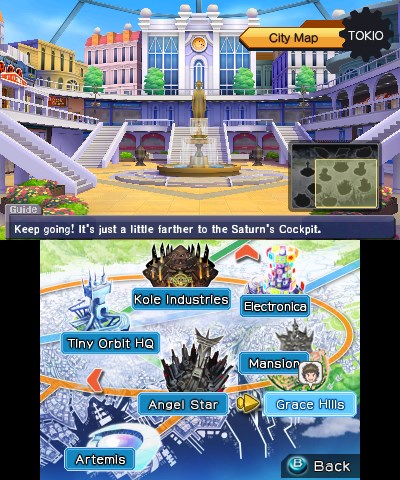Remember kids, don’t talk to strangers… unless they’re handing out robots, then take the damn robot and save the world already.
There are some odd standards when it comes to video game role-playing: ransacking your neighbor’s unlocked houses, doing dangerous jobs for people you’ve never met in towns you’ve never been to, even punching hippies and dogs (thanks for that, Ness). But “entry-level” RPGs usually include one more surprising one, and that is the “child/children being given a life-threatening task in saving the world/defeating a massive evil organization/mafia/syndicate” motif. I suppose in the pixelated ether, there’s just too many people over the age of 14 that don’t have what it takes to take on the rest of the world. They grew out of it, maybe?
In the case of Little Battlers eXperience, enter Van Yamano, the plucky kid of a scientist dad and a mom who doesn’t appear to do anything except scold him. His dad was the one who invented the LBX (short for “tiny fighting robots”), but when his dad disappeared, his mother forbade him to own one, so he learned how to battle with them by using the local shop’s loaner. Together with his friends Amy and Kaz, he practiced without his mother ever knowing. But one day a woman finds and delivers to him an LBX that’s different than any he’s ever seen (and he’s like I was with NeoGeo Pocket Color games in the late '90s; he’s read up on pretty much all of them in the big magazines).
Instead of his mother being horrified by this (as she had previously been), she simply lets him keep it. After all, he needs something to do with his time when he’s so rarely at school and he forgets what floor his class is on. This also means he’s got time to take on an international evil syndicate that’s trying to… I honestly don’t know, do evil? Whatever the case, they can be challenged by a 12-year-old middle school near-dropout, so their (not really) intricate and complex plans are in danger. It’s cheesy, but it’s pretty par for the course for this genre and the dialogue isn’t bad, though it does follow through with every cliché—the supportive friend, the aggressive friend, the stupid-yet-brilliant-in-convenient-way friend, and the motley crew of opponents turned allies. All standard by now.
The game is mostly played out in two forms: collecting and building, and then fighting. Like a child-friendly version of Armored Core, players can amass a number of parts and mix-and-match to their heart’s content, each with a different specialty, weight, and defensive capabilities. From purchased kids and collected loot, you can build with a focus on speed, stamina, power, defense, or just find the parts you like and look as badass as anu 2010-era children’s anime is capable of. As many as there are, each part that’s on your LBX while fighting will “tune up” (level up) after each victory, which actually makes constantly upgrading not very necessary… it’s more about aesthetics and some weight differences on the battlefield.
That’s thankfully not the case for the limited core unit space, where swapping out motors, CPUs, and a few other little odds and ends are plugged in. Those can directly affect how your LBX performs. A better motor may take longer to overheat, but you may not be able to do as much damage. Selecting defense may help if the battle is drawn out, but you might be sacrificing your battery. For those with a thing for numbers and balance, there’s plenty of depth, but if you just want to pick a few weapons and level up, you can jump in and kick a little ass too (once you’ve found a weapon combo that works for your preferences).
And then there’s the actual robot fighting itself, which is a simplified kind of Virtual On environment. Once you’re challenged you can customize a bit, stock up on battle-specific items like healing capsules or offensive/defensive boosts, and start stomping. Fights are fast enough, depending on your LBX’s speed settings and weight—not all LBX are designed the same. Some like the Kunoichi can absolutely fly around the battleground, while others like Bulldozer are… well, they’re damage sponges but their attack power is high. But in the heat of it, one-button weapon strikes, one-button switches to a secondary weapon/set of weapons, and two-button “Special Attack Routines” specific to any of the wide variety of weapons available make it simple to start fighting. Easy to jump into, but the SARs can take a little effort to remember.
There is one glaring absence for a game like this, and that’s online play. There can be up to six players fighting at once on two teams, but only if you have five other friends around with games of their own. Only local multiplayer battles and not online slugfests? C’mon Nintendo, be one of the cool kids! Everybody else is doing it!
This is an animé-based game, which drives the general appearance of everything in the game, and this is one of the best I’ve seen. Usually, when I’ve watched cut-scenes on either the DS or 3DS, there’s an odd encoding issue that pixelates and smudges the corners of everything moving, but here there isn’t any of that. It’s simply… clear. The 3D effects on the animation sequences is awkward, trying to make a traditionally flat visual pop with rounded edges and depth, but for their efforts it just causes more eyestrain than necessary. With the number of tiny in-game corners this is a problem as well. Played with the 3D turned off, save for the occasional curiosity of flat-animation depth, looks crisp and nice (and bonus, no eye-gouging pain!).
With the fun and fast-paced battles and optional collectible nature of items, LBX a solid experience for new players while still accommodating to some old-school-minded folks like me. Looking for a hardcore experience isn’t going to be found here, but for anybody interested in an action-based RPG (that isn’t really an action-RPG), then LBX might be the thing. While the story might be a wash, the action and depth is done well enough to keep the experience engaging.
Now, seriously… what is it about pre-pubescent kids who are worthy of “saving the world”?!
-
Cutscene animation is fantastic (and the rest looks nice too)
-
Battles are fast and engaging
-
Deep customization options
-
No real "need" to customize if you’re not into that sort of thing
-
Story is standard and forgettable
-
Armored Core meets Virtual ON meets Pokemon
-
3D is weird at best, painful at worst
-
No online multiplayer, local only
LBX
-
LBX #1
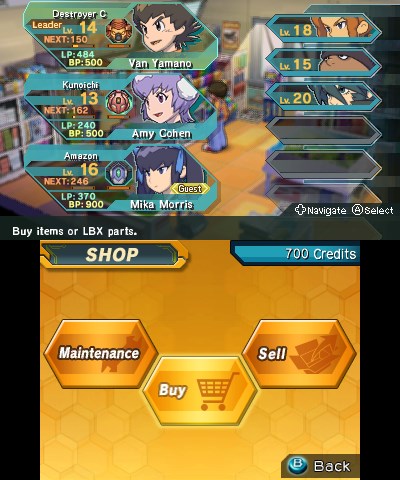
-
LBX #2
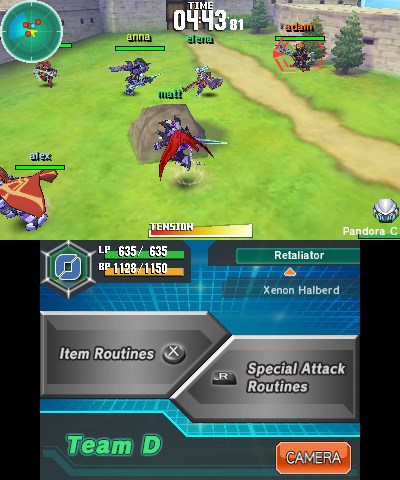
-
LBX #3
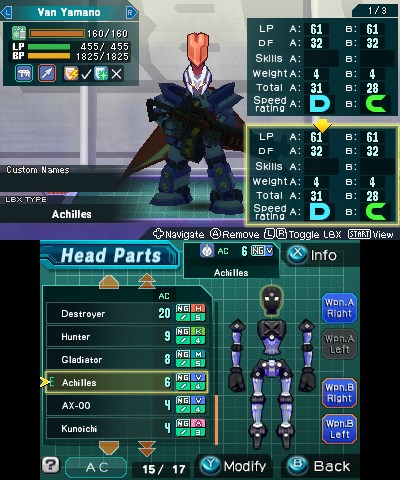
-
LBX #4
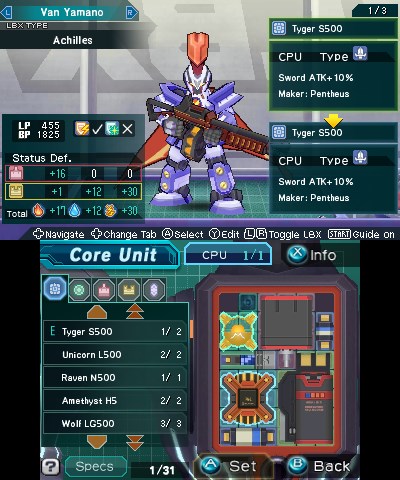
-
LBX #5

-
LBX #6
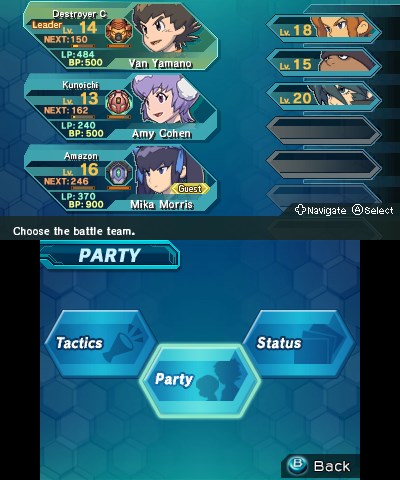
-
LBX #7

-
LBX #8
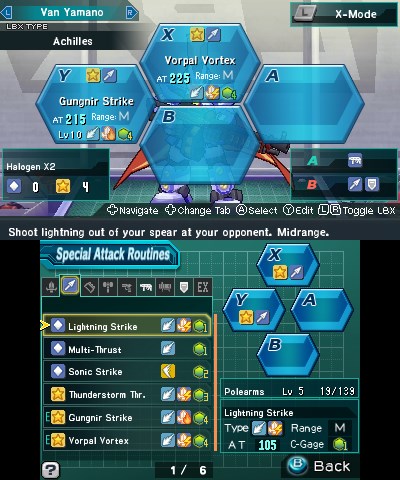
-
LBX #9
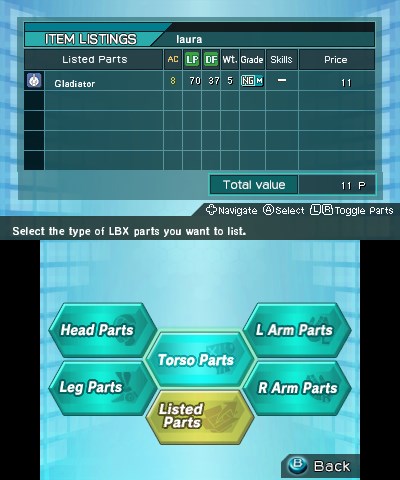
-
LBX #10
